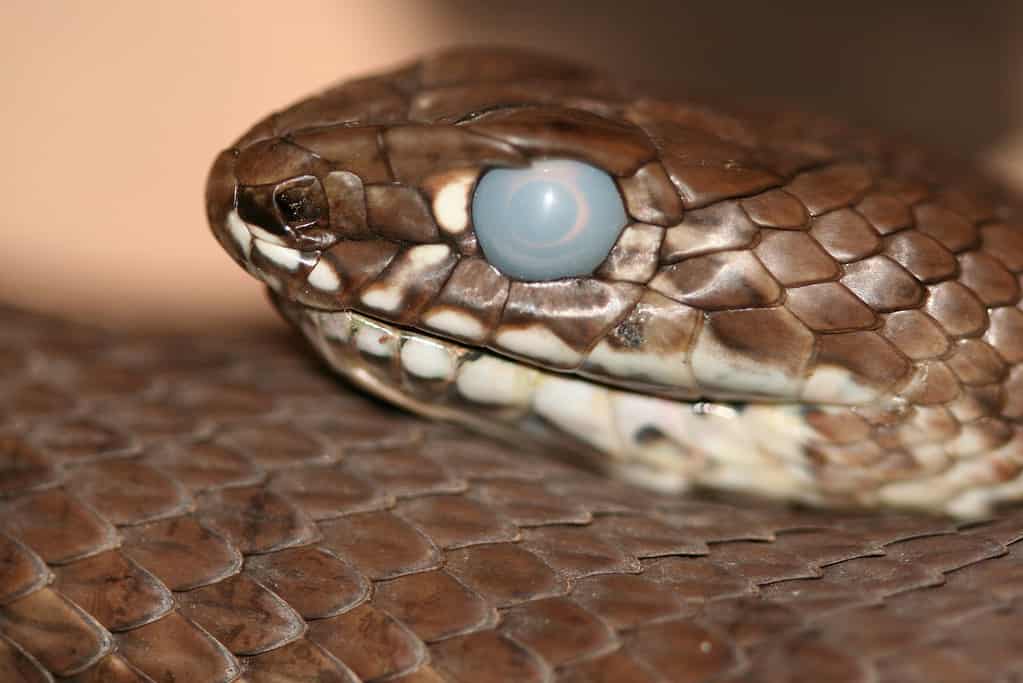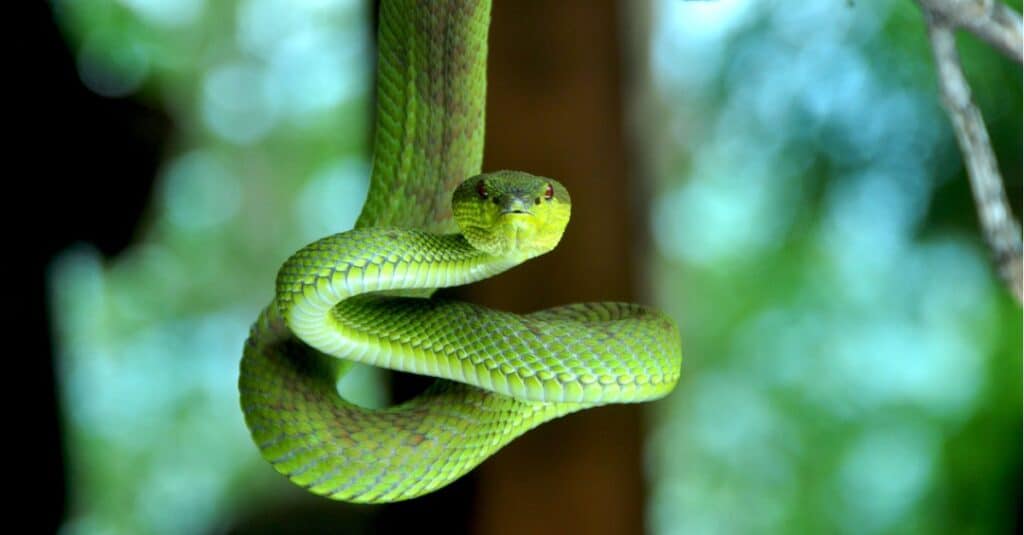Snakes are known as adept and clever hunters, distinguished by their lack of eyelids and external ears. These elongated reptiles are many in number, with over 3,600 known species. But how do these carnivores catch their prey so swiftly? In this article, we’ll be taking an in-depth look into how snakes see and why their eyesight plays such a critical role in the behavior of their species.
Understanding snake vision isn’t just interesting, it’s also crucial information to understand the ecological role snakes play. Having a fuller idea of how snakes see the world, how they hunt, and how they interact with their environment can help manage how they interact with humans and help in learning how to conserve this slithering species.
The Anatomy of Snake Eyes

Instead of eyelids, snakes have scales that cover their eyes. These scales shed alongside the rest of them during molting.
©Frank Buchter/iStock via Getty Images
One of the keys to understanding how snakes see is looking at the literal anatomical structure of their eyes. The first interesting tidbit is that snakes don’t have any eyelids. So, how do they manage to keep out bacteria and debris? Why, scales, of course! Their eyes are covered by transparent scales known as spectacle scales or eye caps. These scales help to protect and shield the snake’s eyes from dirt and other damaging materials. Like the rest of their scales, these shed during their molting period.
The lens in a snake’s eye is more spherical than that of humans. This allows for sharper focus, which is part of the reason why they move so swiftly. Their retina consists of rod and cone cells and helps them to detect light and color. Their rod cells, which they have the majority of, are sensitive to light and movement but not color. Because of this, many believe that there are several snake species that can’t see color. But, some snakes do have cone cells, meaning colorblindness isn’t an overall trait of the species.
Special Visual Organs
Snakes don’t see the same way we do- they see much more, in fact! Some snakes have specialized organs that enable them to detect different forms of heat and light. This allows them to perceive their environment in interesting ways.
These organs, known as pit organs, are possessed by many kinds of vipers, pythons, and boas. These organs are located between the nostrils and eyes of the snake and allow them to detect infrared radiation! So, once they see a warm-blooded mouse or other small animal hiding, they can easily find them. This thermal outline can be seen even in complete darkness, and it’s a key component in the snake’s ability to hunt nocturnally.
How Well Can Snakes See?

Since many snakes have eyes placed on the sides of their head, they have a much more limited field of view than other creatures.
©Matt Cornish/Shutterstock.com
Visual acuity is a fancy way of saying “clear and sharp vision.” The visual acuity that snakes have varies a lot depending on the species and how they’ve adapted. For example, arboreal (tree) species have fantastic visual acuity because they spend most of their lives underground! Diurnal snakes, which are active during the daytime, have very well-developed vision because they need to detect things like color and movement. On the other hand, nocturnal species don’t really need those traits. Instead, they concentrate on things like heat detection or scent.
The Limitations of Their Vision
How snakes see is very specialized to their habits and traits. So, there are areas where they’re lacking. That’s because, evolutionarily speaking, they are areas that they didn’t exactly need to prosper and adapt. Here are two such areas:
Field of View
The majority of snakes have eyes placed on the sides of their head. This means their field of view is much narrower than many other creatures. Some snakes, though, actually have eyes positioned at the tops of their heads. This is because it gives them a better look at their overhead environment, which is very useful for detecting predators and prey in tree-heavy settings.
This all being said, their elongated body permits them to lift their heads to pretty substantial heights and directions, which alters their visual field in a very beneficial way. They can look around without moving their entire body, which helps them take some peeks without exposing themselves to any nearby predators.
Colors and Details
As mentioned briefly, snakes lack (or at least have fewer) cone cells. This means that color and detail perception is far worse than other creatures. However, the presence of more rod cells means that their light sensitivity is far more enhanced. For how snakes see as nocturnal species, this is much more useful than perceiving color.
The Impact That Vision Has on Snake Behavior

Alongside their hunting strategies, many snakes have defensive tactics that revolve around visuals. One of these tactics is the hooding in cobras, meant to make the snake look large and intimidating to predators.
©Roberto 33/Shutterstock.com
Something quite interesting about these reptiles is that how the snakes see directly impacts their hunting strategies. Many snakes, for instance, are ambush predators. They rely on camouflage and stillness to avoid getting seen by prey. These snakes often have the adaptation of pit organs, which, as mentioned, help with spotting infrared radiation.
Other snakes, like colubrids, for instance, are active hunters. This means that they are constantly moving around on the hunt for prey. These snakes, comparatively, have really well-developed sight. They can use this color vision and visual acuity to detect and track down prey even from a great distance.
Aside from attacks, vision plays a big role in a snake’s defense as well. Snakes usually rely on visual cues to detect threats, and many species use visually-based threat displays as a way to drive away unwanted company. A good example of this is the rattlesnake or the hooding in cobras.
Snake Vision From An Evolutionary Perspective

The way that snake vision and survival intertwine is very interesting from an evolutionary standpoint.
©iStock.com/Handini_Atmodiwiryo
To wrap up this information on how snakes see, we should talk about how these reptiles have adapted their vision so well over the course of the millions of years they’ve been around. Early snakes, very likely, evolved from burrowing and aquatic creatures. If this is true, it would explain their initial visual regression- snakes that are underground or in the water definitely shouldn’t rely on vision.
It’s interesting to compare the vision of a snake to that of other reptiles or other members of the animal kingdom in general. Lizards, for example, have developed exceptional color vision. Despite being in the same class, snakes have culminated opposite visual strengths over time, like movement detection and infrared sight. Snakes are unique in this way, and the way that their senses have developed as a reflection of their environment is a really interesting phenomenon!
Unfortunately, studies involving snake vision are few and far between. One study, developed by a team at the London National History Museum, had some interesting findings. After studying 69 different snake species, they discovered that snakes (the ones who see color at all, anyway) see two primary colors as opposed to the three that humans do. They also discovered that, despite being sensitive to UV light, snakes have developed special UV lenses that help block this light and allow them to see more clearly.
What that study, this article, and all of this information are meant to prove is that how snakes see has been changing and adapting since their conception. Snake vision is an excellent example of how adaptation and evolution can play the most essential role in a species’ survival. Through understanding how snakes see, we can also better understand how genetic development really operates.
The photo featured at the top of this post is © reptiles4all/Shutterstock.com
Discover the "Monster" Snake 5X Bigger than an Anaconda
Every day A-Z Animals sends out some of the most incredible facts in the world from our free newsletter. Want to discover the 10 most beautiful snakes in the world, a "snake island" where you're never more than 3 feet from danger, or a "monster" snake 5X larger than an anaconda? Then sign up right now and you'll start receiving our daily newsletter absolutely free.
Thank you for reading! Have some feedback for us? Contact the AZ Animals editorial team.






